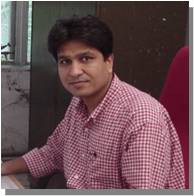|
Prof Anil Kumar |

Academic Background
Professional Experience
Research Interests
I did my Ph. D. under the guidance of Prof. S. Ramakrishnan at the Department of Inorganic and Physical Chemistry, Indian Institute of Science, w:st="on"> w:st="on">Bangalore (www.ipc.iisc.ernet.in). The topic of my research was "STUDIES ON HYPERBRANCHED POLYMERS". My initial work wasfocussed on the synthesis and characterization of dendrimer/hyperbranched polymers (A. Kumar & S. Ramakrishnan, Macromolecules, 1996, 29, 2524). We reported the first example of wholly aromatichyperbranched polyurethane (A. Kumar & S. Ramakrishnan, J. Chem. Soc. Chem. Comm. 1993, 1453) and also synthesizedhyperbranched polyesters with functional oligoethyleneoxy spacers between the branching points. Later, we focussed out interests on studying the effect of branching and of molecular "kinks" on the mesophasic transition in the case of main chainthermotropic liquid crystalline polyesters (A. Kumar & S. Ramakrishnan, Macromolecules, 1996, 29, 8551). In August 1995, I moved to Prof. John Reynolds group (http://www.chem.ufl.edu/~reynolds) as a postdoc at the Universityof Florida, Gainesville, U.S.A.and started working in the field of conducting polymers. Here, our primary interest was in the design and synthesis of soluble andprocessable electrochromic materials (A. Kumar & J. R. Reynolds, Macromolecules, 1996, 29, 7629). We reported, for the first time, an exhaustive study on the effect of alkyl group and the length of thealkylenedioxy ring on the electrical and optical properties of PEDOT (A. Kumar et. al., Chem. Mater., 1998, 10, 896). Thedimethyl substitutedPProDOT was found to give maximum contrast and faster switching speed (D. M. Welsh, A. Kumar, E. W.Meijer and J. R. Reynolds, Adv. Mater., 1999, 11, 1379). We also explored, successfully, the possibility of using textile fabrics coated with conducting materials as gas sensors (Dilek Kincal, A. Kumar, A. Child, J. R. Reynolds, Synthetic Metals, 1998, 92, 53). Later, in September 1997, I moved to the group of Prof. E. W.Meijer (http://www.chem.tue.nl) at theEindhoven Technical University, Netherlands, and there I was involved in the field of dendrimers, conducting polymers for biosensor applications andsupramolecular chemistry. We reported the first example of hyperbranched polymer based on urea linkages (A. Kumar and E. W.Meijer, J. chem. Soc., Chem. Comm., 1998, 1629). Awards and Prizes Scopus Young Scientist Award in CHE in CHEMISTRY for year 2007
Positions Held
|